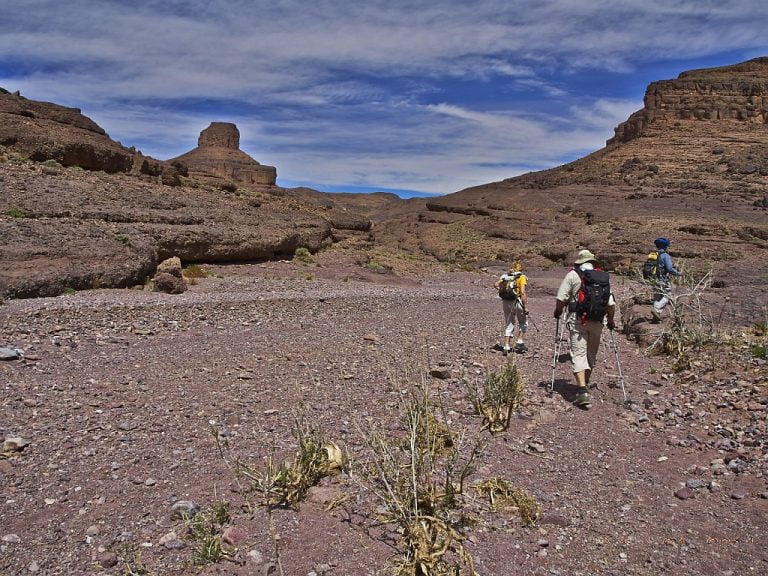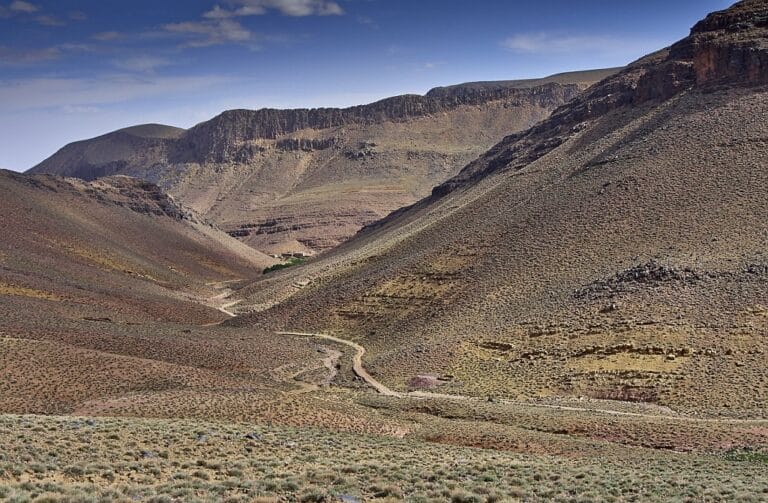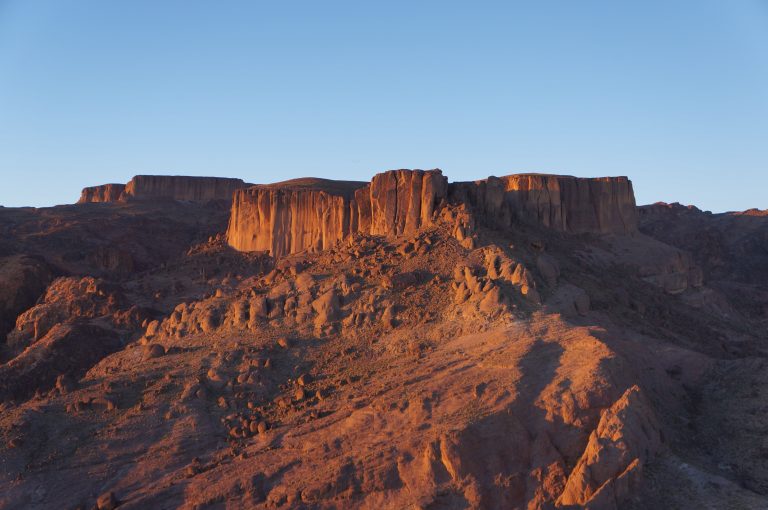Jbel Saghro 8 Days
Jbel Saghro 8 Days
The Jbel Saghro is a mountain range that lies between the High Atlas and the Sahara. It is the eastern extension of the High Anti-Atlas, and it is a place of extreme differences. One minute, a route can pass through date palms, the next through groves of acacia trees, and so on.
Jbel Saghro 8 Days
Jbel Saghro 8 Days
The Jbel Saghro is a mountain range that lies between the High Atlas and the Sahara. It is the eastern extension of the High Anti-Atlas, and it is a place of extreme differences. One minute, a route can pass through date palms, the next through groves of acacia trees, and so on.
Jbel Saghro
Jbel Saghro 8 Days
SAGHRO TREKKING HIGHLIGHTS:
- Find out where Jebel Saghro’s greatest spots are.
- Go to Morocco and have an incredible hiking experience.
- Ait Atta nomadic tribe
- Bab N Ali rock fomation
- The Saghro Massif’s valleys and communities
Jbel Saghro 8-Day Itinerary:
DAY 1: TRANSFER TO YOUR HOTEL UPON ARRIVAL IN MARRAKECH
Meet with our agent at the airport, then be driven to your lodging. During the trip briefing, your tour guide will meet you in the early evening.
- Meals: D

DAY 2 : MARRAKECH - TICHKA PASS - OUARZAZAT - TAGOUDILT VILLAGE 1650M
You will depart early from Marrakech to explore the Anti-Atlantic Mountains. Today’s journey will take you through the High Atlas Range, which is famous for its beautiful valleys and breathtaking landscapes. After crossing Morocco’s highest vehicular pass, Tichka Pass (2260m), you will reach the arid hills and dry plains of Ksar Ait Ben Haddou. This exceptional fortified site, made of adobe architecture, has been recognized as a World Heritage Site by UNESCO since 1987.
It has also served as a filming location for movies like “Gladiator,” “Lawrence of Arabia,” and “Alexander.” Continuing your drive into the afternoon, you will follow the ancient caravan route known as the Valley of 1,000 Kasbahs. Finally, you will arrive at the village of Tagoudilt (1650m) in the late afternoon, where you will spend the night in a family guesthouse.
Total drive: approx. 8 hours.
Meals: B/L/D
DAY 3 : TAGOUDILT (1650M) - ALMOU NOUARG(2200 M)
Your first day of hiking in Jbel Saghro begins with a climb up an old trail that passes by a number of century-old junipers and some areas of grassland. Once you reach the plateau of Iskn’Alla (2500m), you can continue hiking uphill to a small mountain pass for a fantastic panoramic view of Mount Mgoun.
After taking a stop for lunch at the pass, you resume your journey through pastureland with a few rock shelters, where you can come across shepherds calling their cattle. You then descend a hill to your tent along the Almou N. Ouareg river, which is a seasonal river.
Meals: B/L/D


DAY 4 : ALMOU NOUARG (2200M), KOUAOUCK SUMMIT (2600M), IGLI (1850M)
The highest peak in the Anti Atlas Mountains is the Kouaouch summit (2600m), also known as the landmark by the nomads. From there, you can witness the stunning view of Jebel Saghro, which will leave you amazed. The rock formations are captivating, with steep cliffs, rock towers, and solid volcanic tables towering over the valley. The view and the geology from the summit are truly awe-inspiring.
You descend and find yourself in the town of Igli, where your second camp is located. As you hike down, you will encounter surprising boulders containing crystals. On your way, you will also pass by the impressive Tassegdilt Tamajgalt table, where you might catch a glimpse of the legendary camel head. Spend the night near the cultivated fields and almond groves.
7.30 hours trek.
Meals: B/L/D
DAY 5 : IGLI (1850M) - BAB N'ALI(1360M)
Ascend a tall ridge to enjoy panoramic vistas of the surrounding mountains. Follow the path that takes you to the Berber village of Boulouze and a verdant valley. As you stroll along the riverbed, you might be welcomed by a nomadic family who may offer you a refreshing cup of tea. At midday, savor a delicious picnic prepared by your chef in the cool shade of the valley. In the afternoon, make your way on foot to your third camp, nestled beneath the famous Babn’Ali pinnacles.
6 hours trek.
Meals: B/L/D


DAY 6 : BAB N'ALI(1360M)- ASSIF NIRRAZZOUN (1200M) - HANDOUR VILLAGE
Visit Jebel Saghro Bab N Ali, or the Gate of Ali, on a side trip, where your guide will explain the origins of the names of these two rock towers. Descend from Bab n’ Ali to the town of Ighazoun Nimlas, situated in the narrow Amguis valley at the foot of rugged peaks.
To reach the valley of Igue, which is dotted with settlements surrounded by date palms and almond trees, cross the plateau adorned with magnificent stone formations. The South is renowned for its clear skies, fertile fields, and red soil from the local homes. As you approach the valley’s entrance, you’ll come across a vast plateau that opens up to the south. Finally, you’ll arrive at the cliff-top settlement of Handour.
approx. 6 hours of trek
Meals: B/L/D
DAY 7 : HANDOUR VILLAGE TO MARRAKECH
After bidding farewell to your chef and mule leaders, you express your gratitude for their excellent work this morning. Then, you leave Handour and journey through the palm plantations of the Draa Valley towards Ouarzazat. In the afternoon, you traverse the High Atlas Mountains en route to Marrakech. You have a free evening to explore the vibrant nightlife of Marrakech.
Approx. 7 hours drive.
Meals: B/L/D

DAY 8 : MARRAKECH - HOME
When you depart, we can organize a morning guided city tour of Marrakech to explore the souks and Medina.
Meals: B
Trip Details:
- Duration: 8 Days
- Trip Grade: Medium to Hard
- Trip Cost: On request
- Destination: Anti-Atlas Mountains
- Best Season : Mai to November
- Transportation : Private Vehicle
- Maximum Altituted: 2,660 m/ 8227,26 ft
- Group Size: Min 2 person, Maximum 18
What is Included:
- Transfers from and to your hotel
- English, French speaking Berber tour leader
- Accommodation Camping
- Mules to carry your luggage during days of the trek
- Cooking man who prepares all the meals during the trek
What is Not Included:
- Soft drink ( water….)
- Personal travel insurance
- Tips
- Drinks

Morocco Berber History
Believe it or not, Berber history goes back to prehistoric times. In fact, Morocco is home to the oldest Homo Sapiens ever found — nearly 300,000 years old! This means that the indigenous people of Morocco have been here for a long, long time. Longer than any other known group of people in the world.
Much of what we know about the very first people of Morocco come from archeological records. Of the Berbers themselves, well, much of that history is oral. In fact, it’s probably a mistake to call them “Berber” at all!
The Berbers proudly call themselves the Amazigh, the “free people.” The name “Berber” derives from “Barbary,” that is, from the Greek barbaria. Though “Berber” is commonly used throughout Morocco, both by those who identify as Amazigh, and other Moroccans, it’s probably not the nicest or most accurate name.
Thousands of years ago, the Amazigh ruled all of North Africa, largely through different tribes. They would crisscross over the Sahara and throughout the southern basin of the Mediterranean for trade and travel. Over the centuries, they have been called by many names: The ancient Greeks called them “Libyans”;
Romans called them variously “Numbians,” and “Africans” while much of medieval Europe referred to this collection of tribes in North Africa as “Moors.” In fact, it was the Arabs who came up with the Berber name: Al-Barbar. This was likely a re-adaptation of the ancient Greek term of “barbar.” However, there is some thought, as written by the Arab scholar Ibn Khaldun, that there could have been an ancient person by the name of “Barbar,” in some texts, a mother named “Barbara,” who gave the name to the tribes, perhaps around Somalia.
Moulay Idriss, the founder of modern Morocco, escaped from the Abassid Dynasty and introduced Islam to the Awraba tribe, establishing the Idrissid Dynasty. Before this, the majority of Berbers in North Africa followed Anamism, Christianity, or Judaism. Islam rapidly spread throughout the region, albeit with some variations from Middle Eastern practices. The Almoravids and Almohads, two prominent Moroccan dynasties, were Islamic Berber dynasties that governed extensive territories in Spain and northwest Africa.
Throughout history, the Amazigh people have engaged in battles, trade, and negotiations and have welcomed various civilizations such as the Phoenicians, Carthaginians, Romans, Arabs, Spanish, and French. Despite attempts by the Romans and others to colonize the Berber people, they have successfully preserved their language and culture.
In fact, they have never been conquered! The Berber language is primarily spoken, but they also developed their own writing system over 2,500 years ago. Although it may be challenging to locate, the earliest writings can be found in small museums in the southern region. In recent times, the language has been officially standardized and is now recognized as one of the two official languages of Morocco, alongside classical Arabic.

